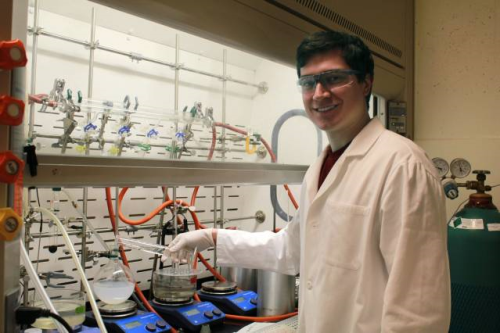
In a paper published recently in the journal Angewandte Chemie, an MIT team has explained a process of synthesizing catalysts made using modified tungsten carbide (WC) nanoparticles as an alternative to platinum.
While platinum-group metals (PGMs) make the most stable and active catalysts, they are unsustainable resources.
In this way, tungsten, with six valence electrons, can be electronically modified to mimic platinum, which has 10 valence electrons, by reacting it with carbon (four valence electrons) to give the ceramic material tungsten carbide. Numerous studies have shown that WC is indeed platinum-like, and able to catalyze important thermo and electrocatalytic reactions that tungsten metal cannot — such as biomass conversion, hydrogen evolution, oxygen reduction, and alcohol electrooxidation. Importantly, tungsten is more than three orders of magnitude more abundant than platinum in the Earth’s crust, making it a viable material for a global renewable-energy economy.
Synthesizing nanoparticles
However, both WC and platinum are heterogeneous catalysts, meaning that they require nanoparticle formulations to create high surface areas and invoke quantum confinement effects to maximize the rates of chemical reactions. While platinum nanoparticles are relatively easy to synthesize, until now, there have been no known methods to synthesize WC nanoparticles less than 5 nanometers and devoid of surface impurities. Tungsten carbide forms at very high temperatures, typically over 800°C (1500°F). These high temperatures cause nanoparticles to sinter into large microparticles with low surface areas. Methods to date that alleviate this agglomeration instead result in nanoparticles that are covered with excess surface carbon. These surface impurities greatly reduce, or completely eliminate, the catalytic activity of WC.
To solve this problem, the MIT team developed a “removable ceramic coating method” by coating colloidally dispersed transition-metal oxide nanoparticles with microporous silica shells. At high temperatures, they show that reactant gases, such as hydrogen and methane, are able to diffuse through these silica shells and intercalate into the encapsulated metal oxide nanoparticles. This transforms the oxide nanoparticles into transition metal carbide (TMC) nanoparticles, while the silica shells prevent both sintering and excess carbon deposition. The silica shells can then be easily removed at room temperature, allowing the dispersal of nonsintered, metal-terminated TMC nanoparticles onto any high-surface-area catalyst support. This is the first method capable of this result.
The team has also been successful in synthesizing the first nonsintered, metal-terminated bimetallic TMC nanoparticles. Electrocatalytic studies have shown that these materials are able to perform hydrogen evolution and methanol electrooxidation at rates similar to commercial PGM-based catalysts, while maintaining activity over thousands of cycles. The catalytic activities obtained were more than two orders of magnitude better than commercial WC powders and WC nanoparticles made by current state-of-the-art synthesis methods that do not prevent sintering or surface carbon deposition.
Catalytic reactions
The team’s next steps include the synthesis of other bimetallic TMCs, as well as transition metal nitride (TMN) nanoparticles. The team is investigating these materials for other electrocatalytic reactions as well as thermal catalytic reactions, such as hydrodeoxygenation for biomass reforming.
“This new method unlocks a broad range of monometallic and heterometallic transition metal carbide and nitride nanoparticles that researchers previously have been unable to synthesize or study," said Yuriy Román, an assistant professor of chemical engineering who worked on the technology. "While our research focuses mainly on the sustainable replacement of PGMs in thermal and electrocatalytic applications, we also anticipate broader impacts of our new TMC and TMN technologies outside catalysis. Because of their unique chemical, mechanical, and electronic properites, carbides and nitrides have garnered much attention for use in applications as diverse as supercapacitors, medical implants, optoelectronics, coatings, and high-temperature materials for the aerospace and nuclear sectors.”
This research was supported by the Department of Energy's Basic Energy Sciences Division.


